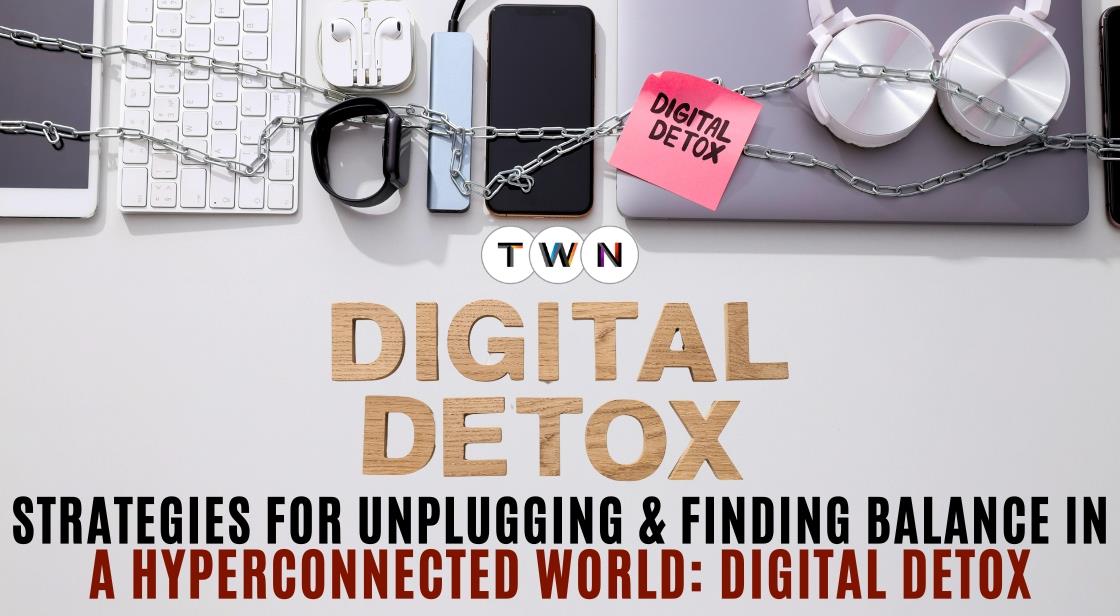Strategies for Unplugging and Finding Balance in a Hyperconnected World: Digital Detox

Blog Post
In today's hyperconnected world, where smartphones, social media, and digital devices are omnipresent, it's easy to feel overwhelmed and consumed by the constant flow of information and notifications.
Many of us find ourselves perpetually plugged in, leading to feelings of stress, anxiety, and a lack of balance in our lives. However, there is a growing recognition of the importance of taking a step back from the digital world and engaging in a "digital detox."
A digital detox involves intentionally disconnecting from digital devices and platforms for a set period, allowing oneself to recharge, reconnect with the physical world, and regain a sense of balance. This practice is not about rejecting technology altogether but rather about cultivating a healthier relationship with it.
In this Article, we'll explore various strategies for unplugging and finding balance in our hyperconnected lives through a digital detox. From setting boundaries with technology to engaging in offline activities, we'll delve into practical tips and techniques to help you reclaim control over your digital habits and prioritize your well-being.
Whether you're feeling overwhelmed by constant connectivity or simply seeking a reprieve from the digital noise, embarking on a digital detox can be a transformative journey towards greater mindfulness, presence, and balance in an increasingly digital world.
Strategies for Unplugging in a Hyperconnected Society
1. Understanding Hyperconnectivity: The Digital Age Dilemma
What is Hyperconnectivity Definition:
-
Hyperconnectivity describes the perpetual state of being connected to digital devices and online platforms.
-
It entails continuous access to information and communication channels, regardless of time or location.
Integration of Technology:
-
In the digital age, technology has become deeply ingrained in various aspects of daily life.
-
Boundaries between work, leisure, and personal time have blurred due to the constant accessibility of digital tools.
Challenges of Hyperconnectivity:
-
Information Overload: With vast amounts of data available at our fingertips, individuals may struggle to process and prioritize information effectively.
-
Digital Fatigue: Constant exposure to screens and notifications can lead to mental exhaustion and burnout.
-
Decreased Productivity: Distractions from digital devices may hinder concentration and hinder task completion.
Importance of Understanding Hyperconnectivity:
-
Recognizing the implications of hyperconnectivity is essential for addressing its challenges.
-
Understanding its impact allows individuals to adopt strategies to manage digital habits and find balance in a tech-centric world.
2. Signs of Overconnectivity: Recognizing the Need for Balance
Constant Checking:
-
Individuals may find themselves frequently checking their emails, social media accounts, or notifications throughout the day.
-
This behavior can become habitual, leading to a constant need for digital stimulation and validation.
Difficulty Focusing:
-
Overconnected individuals may struggle to focus on tasks without frequent interruptions from digital devices.
-
Constant notifications and distractions hinder productivity and concentration, making it challenging to complete tasks efficiently.
Anxiety and Stress:
-
The inability to access the internet or social media platforms can trigger feelings of anxiety or stress in overconnected individuals.
-
They may feel disconnected from the digital world and worry about missing out on important updates or information.
Neglecting Real-Life Relationships:
-
Overconnectivity often results in neglecting real-life relationships and activities in favor of online interactions.
-
Individuals may prioritize virtual connections over face-to-face interactions, leading to feelings of isolation and loneliness.
Recognizing the Signs:
-
Acknowledging these signs is the first step towards realizing the need for balance and implementing strategies for digital detox.
-
By identifying these behaviors, individuals can take proactive steps to reduce their dependence on digital devices and create a healthier relationship with technology.
3. The Concept of Digital Detox: What It Means and Why It's Important
Digital detox defined:
-
Digital detox is a deliberate break from digital devices and online activities for a set period.
-
During this time, individuals refrain from using smartphones, computers, social media, and other digital tools.
Purpose and objectives:
-
The primary goal of a digital detox is to recharge and reset the mind by disconnecting from the constant stream of information and stimuli.
-
It provides an opportunity to reconnect with oneself, focus on personal well-being, and rediscover offline activities and interests.
Importance for mental health:
-
Digital detox is essential for mental health and well-being as it helps alleviate stress, anxiety, and burnout associated with constant digital connectivity.
-
It allows individuals to regain control over their digital habits, reduce screen time, and establish healthier boundaries with technology.
Improving focus and productivity:
-
By taking a break from digital distractions, individuals can improve concentration, productivity, and creativity.
-
Digital detox enables a clearer mind and sharper focus on tasks, leading to more efficient work and better decision-making.
Fostering healthier relationships:
-
Disconnecting from digital devices encourages face-to-face interactions and strengthens relationships with family, friends, and colleagues.
-
It promotes active listening, meaningful conversations, and genuine connections, enhancing the quality of interpersonal relationships.
Overall well-being benefits:
-
Digital detox contributes to overall well-being by promoting relaxation, mindfulness, and self-care.
-
It allows individuals to engage in offline activities, such as exercise, hobbies, and nature exploration, which contribute to physical, emotional, and spiritual health.
4. Setting Boundaries: Establishing Limits in a Hyperconnected World
Definition of Setting Boundaries:
- Setting boundaries involves defining specific times and situations for using digital devices and engaging with online content.
Examples of Boundaries:
Tech-Free Zones:
- Designating areas like bedrooms or dining areas where digital devices are not allowed.
Screen Time Limits:
- Setting specific time limits for using digital screens each day to avoid excessive usage.
Device Usage Rules:
- Establishing rules for when and where devices can be used, such as during meals, family time, or social gatherings.
Importance Setting Boundarie:
-
Boundaries help individuals regain control over their digital habits.
-
They promote a healthier balance between online and offline activities, reducing the negative effects of overconnectivity.
Benefits of Setting Boundarie:
-
Increased productivity: Setting boundaries can help individuals focus on tasks without constant digital distractions.
-
Improved relationships: By establishing rules for device usage during social interactions, individuals can foster deeper connections with others.
-
Better sleep quality: Tech-free zones in bedrooms promote relaxation and improve sleep hygiene.
-
Enhanced well-being: Limiting screen time and setting boundaries around device usage can reduce stress and improve overall mental health.
Implementation of Setting Boundarie:
-
Communicate boundaries with family members or roommates to ensure everyone is on the same page.
-
Use tools and apps to track screen time and enforce limits if needed.
-
Be consistent and firm with boundaries, but also flexible enough to adjust them as needed based on individual circumstances.
5. Practical Strategies for Unplugging: Tips for Implementing a Digital Detox
By implementing these practical strategies, you can gradually reduce your reliance on digital devices and create a healthier balance between online and offline activities in your life.
Schedule Regular Digital Detox Periods:
-
Designate specific times, such as weekends or evenings, for disconnecting from all digital devices.
-
Use this time to engage in offline activities and focus on personal well-being without the distraction of screens.
Utilize Smartphone Apps or Built-in Features:
-
Explore apps or features on your smartphone that allow you to track and limit screen time.
-
Set daily or weekly limits for app usage and receive notifications when you approach or exceed these limits.
Also Read: 5 Things You Need To Know About Social Media Marketing
Practice Mindfulness Techniques:
-
Incorporate mindfulness practices, such as deep breathing or meditation, into your daily routine.
-
These techniques can help reduce stress and increase awareness of your digital habits, making it easier to disconnect when needed.
Engage in Offline Activities:
-
Identify offline activities that you enjoy, such as reading, exercising, or spending time outdoors.
-
Make time for these activities regularly to cultivate balance and fulfillment outside of the digital realm.
Prioritize Face-to-Face Interactions:
-
Make a conscious effort to prioritize face-to-face interactions with friends and family members.
-
Schedule regular gatherings or outings where you can connect in person and strengthen relationships offline.
Set Goals and Track Progress:
-
Set specific goals for reducing digital dependency and improving your digital habits.
-
Keep track of your progress over time by monitoring changes in your screen time, productivity, and overall well-being.
6. Mindfulness and Meditation: Techniques for Finding Balance Amidst Connectivity
Definition of Mindfulness:
-
Mindfulness entails being fully present and attentive to the current moment, without passing judgment on experiences or thoughts.
Awareness of Digital Habits:
-
Practicing mindfulness allows individuals to observe their digital habits objectively, helping them recognize patterns of overuse or dependency.
Conscious Decision-Making:
-
By fostering mindfulness, individuals can make deliberate choices about their technology use, opting for balance and moderation.
Definition of Meditation:
-
Techniques for Stress Reduction and Focus Enhancement
Focused Breathing: This meditation technique involves concentrating on the breath, inhaling and exhaling deeply while letting go of distracting thoughts.
Body Scanning: Body scanning meditation involves systematically shifting attention throughout the body, noticing sensations and releasing tension.
Stress Reduction and Concentration: Both focused breathing and body scanning techniques help reduce stress levels and enhance concentration, facilitating disconnection from digital distractions.
Integration into Daily Routine: Promoting Overall Well-Being
-
Consistent Practice: Incorporating mindfulness and meditation into daily routines fosters a habit of presence and self-awareness.
-
Balancing Hyperconnectivity: Regular practice of mindfulness and meditation empowers individuals to find equilibrium amidst the constant connectivity of the digital age.
-
Enhanced Well-Being: By promoting balance and self-awareness, mindfulness and meditation contribute to greater overall well-being in today's hyperconnected world.
7. Engaging in Offline Activities: Rediscovering the Joys of the Physical World
Disconnecting from Digital Devices:
-
Offline activities offer a break from constant digital stimulation, allowing individuals to reconnect with the tangible world around them.
-
By stepping away from screens, individuals can reduce stress, improve focus, and foster a greater appreciation for real-life experiences.
Examples of Offline Activities:
-
Outdoor Exploration: Spending time in nature through activities like hiking, gardening, or picnicking allows individuals to breathe fresh air, soak in natural beauty, and engage in physical exercise.
-
Creative Pursuits: Pursuing hobbies such as painting, cooking, or playing musical instruments provides opportunities for self-expression, creativity, and personal fulfillment.
-
Group Engagement: Participating in group activities or classes, such as yoga, dancing, or team sports, fosters social connections, teamwork, and a sense of community.
Benefits of Offline Engagement:
-
Enhanced Well-being: Engaging in offline activities promotes mental and emotional well-being by reducing stress, increasing mindfulness, and promoting relaxation.
-
Social Connections: Participating in group activities allows individuals to connect with others face-to-face, strengthening relationships and building social support networks.
-
Reduced Digital Dependency: By immersing themselves in offline pursuits, individuals can lessen their reliance on digital technology for entertainment and fulfillment, leading to a more balanced lifestyle.
Importance of Balance:
-
While digital devices offer convenience and connectivity, it's essential to balance online and offline activities to maintain overall well-being.
-
By incorporating regular offline activities into their routines, individuals can cultivate a healthier relationship with technology and enjoy a more fulfilling, well-rounded lifestyle.
8. Creating Tech-Free Zones: Designating Spaces for Disconnecting and Reconnecting
Purposeful Designation:
-
Designating tech-free zones within homes or workplaces provides intentional spaces for individuals to disconnect from digital devices.
-
These zones are strategically chosen to encourage offline activities and foster meaningful connections with oneself and others.
Bedroom Sanctuary:
-
Establishing a rule of no digital devices in the bedroom promotes better sleep quality and reduces late-night screen time.
-
Removing screens from the bedroom environment creates a calming atmosphere conducive to relaxation and restorative sleep.
Dining Area Engagement:
-
Designating the dining table as a tech-free zone encourages family members to engage in face-to-face conversation during meals.
-
By eliminating digital distractions, meal times become opportunities for meaningful interaction and connection among family members.
Relaxation Oasis:
-
Creating dedicated relaxation areas, such as reading nooks or meditation corners, provides a sanctuary from digital distractions.
-
These spaces are intentionally designed to promote relaxation, mindfulness, and introspection without the interference of digital devices.
Promoting Healthy Habits:
-
Tech-free zones support healthy habits by encouraging individuals to disconnect from screens and engage in offline activities.
-
By creating environments conducive to relaxation and connection, individuals can prioritize their well-being and foster deeper relationships offline.
Fostering Meaningful Connections:
-
Tech-free zones facilitate opportunities for individuals to reconnect with themselves and others on a deeper level.
-
By removing digital distractions, these spaces encourage authentic communication, quality time, and emotional connection among individuals.
Establishing Balance:
-
Creating tech-free zones helps individuals establish a healthy balance between their online and offline lives.
-
By designating specific areas for disconnecting from digital devices, individuals can cultivate mindfulness, reduce screen time, and enhance overall well-being.
9. Nurturing Relationships: Fostering Meaningful Connections Beyond Screens
By prioritizing offline relationships and investing time and effort into fostering meaningful connections beyond screens, individuals can experience greater fulfillment, support, and happiness in their interpersonal relationships.
Importance of Offline Relationships:
-
Building and maintaining meaningful offline relationships is crucial for overall well-being and happiness.
-
Offline connections offer deeper emotional fulfillment and a sense of genuine human connection compared to digital interactions.
Spending Quality Time Together:
-
Prioritize spending quality time with loved ones, including family members, friends, and romantic partners.
-
Allocate dedicated time for activities that foster bonding and create lasting memories.
Engaging in Shared Activities:
-
Participate in activities together that promote interaction and shared experiences.
-
Activities such as cooking meals, playing games, or taking walks allow for meaningful engagement beyond screens.
Also Read: 4 Proven Social Media Marketing Hacks to Attract More Leads
Facilitating Meaningful Conversations:
-
Foster open and honest communication by engaging in meaningful conversations.
-
Discussing feelings, aspirations, and life experiences can strengthen emotional bonds and deepen understanding.
Prioritizing Offline Interaction:
-
Make a conscious effort to prioritize offline interactions over digital communication.
-
Actively seek opportunities to connect face-to-face, whether through planned outings or spontaneous meetups.
Strengthening Social Connections:
-
Investing time and effort in offline relationships strengthens social connections and fosters a sense of belonging.
-
Building strong offline connections provides a support network for navigating life's challenges and celebrating achievements.
Benefits of Face-to-Face Interaction:
-
Face-to-face interaction allows for non-verbal cues, such as facial expressions and body language, which enhance communication and understanding.
-
Physical presence fosters a deeper connection and creates shared moments that contribute to relationship satisfaction.
Creating Lasting Memories:
-
Engaging in offline activities and conversations creates lasting memories that contribute to the richness of relationships.
-
Shared experiences strengthen bonds and provide a foundation for future connections and shared stories.
10. Reflecting and Reassessing Digital Detox:
Importance of Reflection:
-
Regularly reflecting on the impact of digital detox is crucial for maintaining a healthy balance between online and offline life.
-
It allows individuals to evaluate the effectiveness of their digital detox efforts and identify areas for improvement.
Evaluating Effectiveness:
-
Assessing the impact of digital detox involves considering its effects on overall well-being, quality of life, habits, relationships, and productivity.
-
Individuals can ask themselves specific questions to guide their reflection process.
Identifying Areas for Improvement:
-
Through reflection, individuals can pinpoint specific areas where they may still struggle with overconnectivity or where further adjustments are needed.
-
This self-awareness enables them to make necessary changes to their digital habits and lifestyle.
Making Necessary Adjustments:
-
Based on the insights gained from reflection, individuals can make adjustments to their digital detox strategy.
-
This may involve setting new boundaries, implementing additional strategies for unplugging, or seeking support from others.
Continuing the Process:
-
Reflection and reassessment should be ongoing processes, rather than one-time events.
-
By regularly reflecting on their digital detox journey and reassessing their approach, individuals can continuously refine their habits and maintain a healthy balance between online and offline life.
FAQ for Reflection:
-
How has digital detox impacted my overall well-being and quality of life?
-
What positive changes have I noticed in my habits, relationships, and productivity?
-
Are there areas where I still struggle with overconnectivity, and how can I address them?
You May Like
EDITOR’S CHOICE












